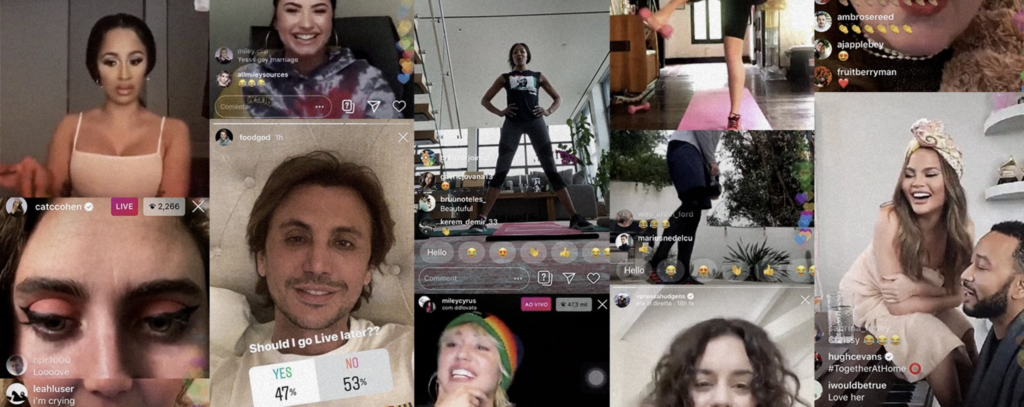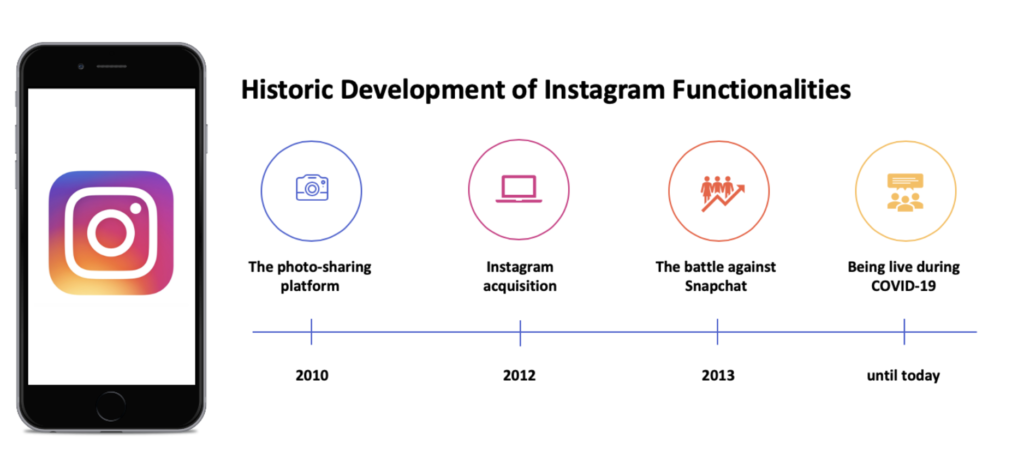Instagram as organizational tool - Conclusion
None of us really knew what to expect before entering this virtual Summer Academy. ⅓ sad not to be in Berlin, ⅓ confused and scared of the virtual awkwardness, ⅓ curious what this virtual context would unveil. We were lucky and directly got along the first day. All very different but all motivated to make this new type of group work a success we all enjoyed our topic and everyday revealed new aspects of the technology we didn’t think about in the past. Everyday was full of improvised “field work” and of constructive discussions, making us aware of so many “hidden” facets of this technology we use in our daily life.
Over the past few days we have analysed the power of Instagram as an organizational tool in today’s society. This platform, which has developed to become one of the most used social apps worldwide and which has proven to be modular and to adapt in times of crisis. With an ever growing range of features, Instagram is today a platform on which practically everything is shared. And there are definitely many things to come in terms of development and influence of Instagram on our way to organize life and social relations.

It was extremely interesting to study the evolution of the social, the perception of the self and the “hidden” not so hidden influence of instagram on our taste, our shopping habits, our thoughts and feelings. Both giving the feeling of safety and belonging as well as evil and destructive Instagram has so many different faces, we unconsciously know but ignore to be part of a bigger thing.
With love,
Aurora De Martin, Emaele de Quatrebarbes, Lara Schulte, Marco Ubalducci & Selma Vuckic

Fight social distancing virtually - Do it with the ‘gram.
In time of COVID-19 and social distancing, technologies such as Instagram have not only supported us in much needed social interactions but provided new ways to organize the daily life of the user base digitally. When we started to look into the development of instagram’s features, how instagram is organizing our lives during COVID-19 and the increase in usage of the Live Function, we see a potential to further investigate the live function of Instagram from a socio-material perspective.
With the emergence of Covid-19 and the global human isolation, people started to find new ways to interact with each other. “Live” streaming on Instagram being one of them. Although this feature was not used as much before the pandemic, the need for human interaction has increased the “live” usage by 70% globally over the past few months (business insider, 2020). The use of “live” videos has enabled sports coaches, cooks, businesses, politicians and more to stay in contact with their public and stimulate human interaction. To enable people to still have activities other than their work and families, instagram users started to create live content for people to pursue their daily sport practices, their passion for cooking and to keep up with the outside world.

https://www.wmagazine.com/story/coronavirus-quarantine-instagram-live-trend-celebrities/
However, before we start discussing if and how Instagram’s “live” function is organized and organizing or if and how the usage is affecting us, we want to take a step back and dive into the historic development of Instagram’s feature set to provide a better understanding of how Instagram’s potentially evolved.

2010 – The photo-sharing platform
In 2010, Instagram emerged as a photo-sharing platform (Lup, Trup & Rosenthal, 2015, p. 247) with the idea to support the cultural trend of pictorial communication. At the beginning the feature set focused on taking and editing pictures and sharing them on a profile (Sheldon & Bryant, 2016, p. 89). However, Instagram has fastly reached an attractive user base, and added possibilities to organize the growing user generated content through hashtags for categorizing and making pictures visible to the right user base (see Sheldon & Bryant, 2016, p. 89). The popularity of Instagram, especially among younger generations, seems to be based on the continuous user-driven as well as user-focused innovations and is reflected in the fast-growing user base, which attracted the attention of competing social networking services.
2012 - Instagram acquisition
In April 2012 Instagram was acquired by Facebook. The original idea of Mark Zuckerberg, CEO of Facebook, was to maintain Instagram independent bringing the team aboard, but this idea evaporated from the beginning because it was so tiny that it needed Facebook’s resources to stay afloat. In fact, at that time, Instagram only had 13 employed people and so far did not generate any revenue. The users were “only” 30 000 before the acquisition and, just after one month, they became 50 000. Nevertheless, the problem of revenues remained. For this reason, Emily White, the director of operations, said that it was necessary to concentrate in “capture and share the world’s moments”, which effectively was the “cool” factor that allowed Instagram to get thousands users in such a short time. In fact, only one year later, users became 150 000. From this moment, Instagram introduced sponsored post advertising which allowed it to get more revenues. Moreover, new features were introduced: first of all, in May 2013, “photo tagging” and “photo of you”, which were already present on Facebook, were added and, after one month, Instagram also launched the possibility of sharing videos of 3-15 seconds. However, there were much more changes to come.
2013 - The battle against Snapchat
In 2013, Facebook made an offer to Snapchat's founders to buy it for $ 3 billion. However, these refused, whereupon Mark Zuckerberg simply copied the main ideas of Snapchat and added them to Instagram. If imitation is the highest form of recognition, as Oscar Wilde once remarked, Instagram has really praised Snapchat the last few years. The similarities to the stories function on Snapchat are undeniable. Instagram CEO Kevin Systrom also admitted that Snapchat deserves all the credit, but also pointed out that it was not about who invented which feature first. It's about a new format and how to use it in your network and make it something unique. Videos on Instagram have recently become a central component of every content strategy. After the maximum length for videos has recently been increased to 60 seconds, Instagram is expanding the video function. The increasing number of Instagram users has led the social network to already introduce Instagram Live Videos in spring 2017, following in the footsteps of its big brother Facebook.
Aurora De Martin, Emaele de Quatrebarbes, Lara Schulte, Marco Ubalducci & Selma Vuckic